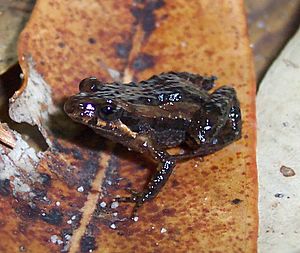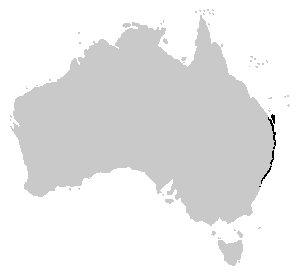Wallum froglet facts for kids
Quick facts for kids Wallum froglet |
|
|---|---|
 |
|
| Conservation status | |
| Scientific classification | |
 |
|
| Wallum froglet range. |
The wallum froglet (Crinia tinnula) is a tiny frog that lives on the ground. You can find it along the east coast of Australia. It lives from southeast Queensland down to Kurnell in New South Wales. This frog especially loves to live in special wet areas called Wallum swamplands.
What They Look Like
The wallum froglet is a very small frog. It grows to be only about 15 millimeters long. That's about the size of your fingernail!
It looks a lot like another frog called the common eastern froglet. To tell them apart, you usually need to listen to their calls. The wallum froglet also has a white stripe on its throat. This stripe goes all the way to the tip of its nose.
Their skin color can be different. It might be grey or brown. The skin usually feels smooth. Sometimes, their backs have spots or stripes, but often they are plain. Their bellies are a mix of black and white, looking a bit marbled.
Where They Live and Their Habits
These frogs only live in special swamps. These are called acid paperbark swamps, found in wallum country.
Male wallum froglets make a high-pitched squeaking sound. They can call at any time of the year, as long as there is water around. The males usually call from hidden spots in the grass. Sometimes, they call while floating in the water.
Life Cycle and Reproduction
Wallum froglets mostly breed during autumn and winter. They lay their eggs in large swamps or in temporary ponds near the swamps. Each egg is laid by itself. The eggs are often attached to twigs and leaves in still water.
The tadpoles are brown and have arched tail fins. They can grow quite large, almost 40 millimeters long. It takes nearly six months for a tadpole to grow into a frog. When they first become frogs, they are very tiny, only 6 to 11 millimeters long.
The swamps where these frogs live are facing problems. More towns and buildings are being built, which can harm their natural homes.
See also
 In Spanish: Crinia tinnula para niños
In Spanish: Crinia tinnula para niños


